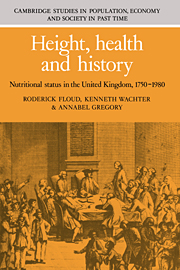Book contents
- Frontmatter
- Contents
- List of figures
- List of tables
- Preface
- 1 Height, nutritional status and the historical record
- 2 Inference from military height data
- 3 Inference from samples of military records
- 4 Long-term trends in nutritional status
- 5 Regional and occupational differentials in British heights
- 6 Height, nutritional status and the environment
- 7 Nutritional status and physical growth in Britain, 1750–1980
- 8 Conclusions
- Bibliography
- Index
1 - Height, nutritional status and the historical record
Published online by Cambridge University Press: 05 November 2011
- Frontmatter
- Contents
- List of figures
- List of tables
- Preface
- 1 Height, nutritional status and the historical record
- 2 Inference from military height data
- 3 Inference from samples of military records
- 4 Long-term trends in nutritional status
- 5 Regional and occupational differentials in British heights
- 6 Height, nutritional status and the environment
- 7 Nutritional status and physical growth in Britain, 1750–1980
- 8 Conclusions
- Bibliography
- Index
Summary
INTRODUCTION
Height matters to humans. It is the stuff of myth and chronicle; ‘there were giants on the earth in those days’ (Genesis 6:4) who were seen by the scouts of the children of Israel when they ventured from the desert into the land of milk and honey: ‘the giants, the sons of Anak, which come of the Nephilim: and we were in our own sight as grasshoppers, and so we were in their sight’ (Numbers 13:33). It is, in many primitive societies, part of the power of kingship that the rulers tower above the ruled, a phenomenon reflected in our language; we speak of ‘looking up’ to our superiors and tell children to ‘stand up tall!’. Tallness is not always a positive characteristic; the short count Socrates, Napoleon and Einstein among their number. But whichever way the connotations run, height is a salient characteristic, one of our primary means of identification, one of the features of the body which it is most difficult to disguise. And it is still one of the most important factors which enters into a choice of girlfriend, boyfriend or marriage partner.
It comes as no surprise, therefore, that travellers in strange lands often comment on the unusual height, whether high or low, of those whom they see. Within a single country, differences in heights between groups have the power to surprise and to shock.
- Type
- Chapter
- Information
- Height, Health and HistoryNutritional Status in the United Kingdom, 1750–1980, pp. 1 - 29Publisher: Cambridge University PressPrint publication year: 1990

